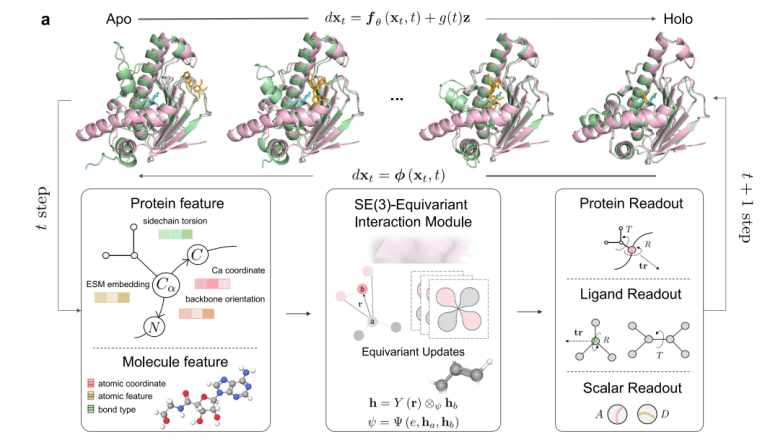- DynamicBind revolutionizes protein-ligand docking and drug discovery through deep learning.
- Traditional methods struggle to capture protein dynamics, hindering accuracy.
- DynamicBind, developed by a collaborative effort, utilizes equivariant geometric diffusion networks to predict ligand-specific conformations efficiently.
- It excels in docking and virtual screening benchmarks, accommodating significant protein conformational changes.
- The model operates as an E(3)-equivariant, diffusion-based graph neural network, enhancing binding affinity predictions.
- DynamicBind offers a versatile tool for predicting protein-ligand complex structures and reducing clashes, showcasing its potential for drug discovery.
Main AI News:
The realm of protein structure prediction has seen remarkable advancements, yet the true essence lies in comprehending the dynamic interplay between proteins and ligands, a pivotal aspect for unraveling protein functionality and propelling drug discovery endeavors. Conventional docking techniques often oversimplify proteins as static entities, thereby constraining their precision. Despite the insights provided by molecular dynamics simulations, their computational demands pose a significant hurdle. Moreover, while innovations like AlphaFold excel in predicting structures from sequences, they fall short in capturing the dynamic spectrum of proteins, thereby compromising docking accuracy and hindering precise predictions.
In a collaborative effort spanning Galixir Technologies, School of Pharmaceutical Science at Sun Yat-sen University, Center for Theoretical Biological Physics, Department of Chemistry at Rice University, and the Global Institute of Future Technology at Shanghai Jiao Tong University, a groundbreaking solution has emerged: DynamicBind. This pioneering deep learning methodology harnesses equivariant geometric diffusion networks to sculpt a seamless energy landscape, facilitating smooth transitions between diverse equilibrium states. Notably, DynamicBind exhibits exceptional prowess in predicting ligand-specific conformations from unbound protein structures, obviating the need for holo-structures or exhaustive sampling. Its proficiency shines in docking and virtual screening benchmarks, adeptly navigating substantial protein conformational variations and unveiling latent binding sites in novel protein targets. With its advent, the trajectory of computational drug discovery stands poised for acceleration.
Expanding on its foundational principles, DynamicBind, a geometric deep generative model tailored for dynamic docking, orchestrates the nuanced adjustment of protein conformations from initial AlphaFold predictions to holo-like states. Its robust architecture seamlessly accommodates pronounced conformational shifts, such as the DFG-in to DFG-out transition in kinases, outstripping the capabilities of traditional molecular dynamics simulations. Central to its efficacy is the acquisition of a funnel-shaped energy landscape that mitigates frustration during transitions across biologically pertinent states. Unlike conventional Boltzmann generators, DynamicBind boasts adaptability to novel proteins and ligands, heralding a new era of versatility in structural prediction.
At its core, the DynamicBind model operates as an E(3)-equivariant, diffusion-based graph neural network, leveraging a coarse-grained representation to anticipate protein-ligand binding conformations. This streamlined approach transcends traditional methodologies by incorporating 3D trans-rotational and parity adjustments with remarkable efficacy, even in scenarios with limited data availability. Leveraging a morph-like transformation for training, DynamicBind seamlessly interpolates between crystal and AlphaFold structures, harnessing the graph representation to imbue each protein residue and ligand atom with diverse features. Through iterative tensor products and diffusion processes, DynamicBind dynamically updates these nodes to forecast side-chain dihedrals, torsion angles, translations, and rotations, thereby enhancing binding affinity prognostications.
In practical application, DynamicBind emerges as a versatile ally for prognosticating protein-ligand complex architectures, demonstrating exceptional adeptness in accommodating substantial protein conformational alterations. During inference, it meticulously fine-tunes ligand positions and internal angles across a 20-iteration cycle while concurrently adapting protein conformations, notably side-chain angles, thereby refining the initial AlphaFold-predicted structures. Diverging from conventional paradigms, DynamicBind eschews Gaussian noise perturbations in favor of a morph-like transformation, thereby bolstering its capacity to capture biologically relevant conformational nuances. Its prowess is evident in ligand pose prediction, where it minimizes clashes and unveils cryptic binding pockets, as substantiated by an array of benchmarks and case studies, underscoring its pivotal role in the realm of drug discovery applications.
Conclusion:
The introduction of DynamicBind marks a significant advancement in the field of protein-ligand docking and drug discovery. Its ability to accurately predict ligand-specific conformations and accommodate substantial protein conformational changes heralds a new era of precision and efficiency in computational drug discovery. With its versatile and robust capabilities, DynamicBind is poised to reshape the market landscape, offering pharmaceutical companies a powerful tool to expedite the development of novel therapeutics and tackle previously challenging drug targets.

